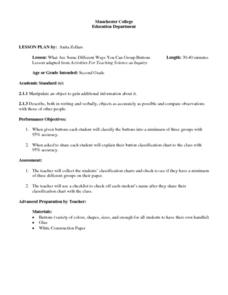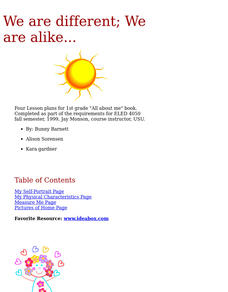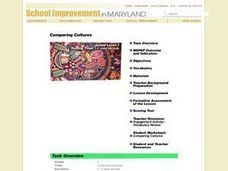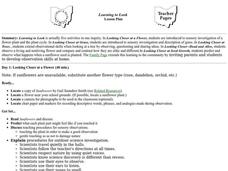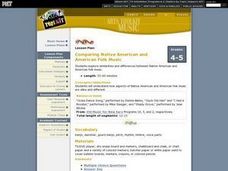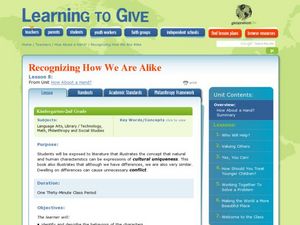Missouri Department of Elementary
How We Are Alike And Different
Scholars develop social awareness by exploring the concept of similarities and differences. Learners examine two beverages and use a Venn diagram to identify similarities and differences. They tally each item to identify if they are more...
Curated OER
How are Seeds Alike and Different?
Second graders examine the seeds in fresh fruit. In this seeds lesson, 2nd graders view different seeds and tell how they are alike and different. Students separate the seeds into groups according to their characteristics.
Curated OER
How We Are Alike And Different
Pupils engage in a lesson that is concerned with the similarities and differences as part of knowing other children. They use examples of different drinks to illustrate the differences or similarities that are present in the student...
Curated OER
The Flow of Women's Work: How Cultures are Alike and Different?
Students examine gender roles in various cultures. In this flow of women's work lesson, students compare water related work in rural Africa to that in their own households.
Curated OER
Library Lesson Plan
Explain the differences between fiction and non-fiction and the characteristics of a biography. Learners analyze three pieces of literature on the same topic to determine which is fiction and which is non-fiction. In the end, relate the...
Curated OER
Where Is Japan? How Are We Alike And Different?
First graders use literature, maps, and globes to explain how physical environments in various parts of the world are similar to and different from one's own, and that certain areas have common characteristics and can be called regions.
Curated OER
Compare and Contrast Two Settings in One Text
Look for the signal words! Scholars get both instruction and practice comparing and contrasting. Although it is completely scripted, it can also serve as a detailed outline. Demonstrate this as you read a passage (included) and search...
Curated OER
What Are Some Different Ways You Can Group Buttons
Second graders classify and group buttons. They discuss how their buttons are alike and different, and identify the characteristics of their handful of buttons. Students then classify their buttons into three groups, and create a...
Arkansas Government
Creative Adventures with Literature - Whoever You Are
Celebrate our similarities and differences through multiple readings of Whoever you Are by Mem Fox. Readings are accompanied by a grand discussion, charts, creative art, dramatic, and music play to reinforce the uniqueness that is...
Curated OER
Getting to Know You
Students converse with each other while playing a game in order to discover things that are alike and things that are different about themselves. The students gather data about themselves, organize and display data on the graph, and...
Peace Corps
Defining Culture
How has culture shaped you? Middle and high schoolers examine different aspects of one's culture, including religious beliefs, social customs, and family traditions, and discuss the ways that their personalities have been formed by these...
Curated OER
We Are Different; We Are Alike........
First graders explain that everybody is unique in their own way by participating in this lively, art and language based series of lesson plans. They would greatly benefit from engaging in these plans in the beginning of the year as an...
Curated OER
Look Alikes
Third graders compare and contrast the physical features of parents and offspring. In this life science lesson, 3rd graders classify a set of animal pictures according to their similarities. They share and explain their work in class.
Curated OER
Comparing Cultures
Young readers compare two stories/cultures, identifying how they are alike and different. They share their own version of a well-known story and adapt it to another culture. They explain their adaptations.
Possibilities
Disability Awareness Activity Packet
Bring awareness to disabilities with a packet consisting of a variety of activities designed to inform scholars about disabilities—autism, hearing impairments, physical disabilities, and more! Learners test their communication...
Curated OER
Author Study: Laura Ingalls Wilder
Students read novel, Little House in the Big Woods, explore web sites and other resources devoted to author, Laura Ingalls Wilder, complete Venn Diagram showing ways they and author are alike and different, and create diorama, read...
Curated OER
Learning To Look
Sixth graders investigate a flower plant and the plant cycle. They extend observational skills when looking at a tree by observing, questioning and sharing ideas. They observe a living and nonliving flower and compare and contrast how...
Curated OER
Comparing Native American and American Folk Music
Students examine how aspects of Native American and American folk music are alike and different. They contrast both forms of music and engage in many activities to identify or explain how music fulfills a variety of purposes.
Curated OER
Making Mittens with The Mitten Book
Students read The Mitten, by Jan Brett, and discuss the different animals in the book. They create a pair of paper mittens that look alike.
Curated OER
Simon Says "Who Are You?"
Students explore their similarities and differences. In this getting to know you instructional activity, students play a variation of "Simon Says," according to various personality and physical traits.
Curated OER
The Legendary Raptors
How are raptors and airplanes alike? Combine science and language arts in this fun and interactive project. Young scientists research the animal in order to design their own aircraft, and compete in a contest for farthest, fastest, and...
Curated OER
Introduce: Comparison and Contrast
Class discussions can really make concepts come to life. The class discusses the differences between compare and contrast, read a book, then talk about ways they can compare events or characters in the story. Good leading question are...
Curated OER
Digital Plants...Alike and Different!
Third graders. in groups, take pictures of plants and turn them into a learning game.
Curated OER
Recognizing How We Are Alike
Young scholars explore the concept of social justice. In this service learning worksheet, students read The Sneeches in order to appreciate cultural uniqueness.









